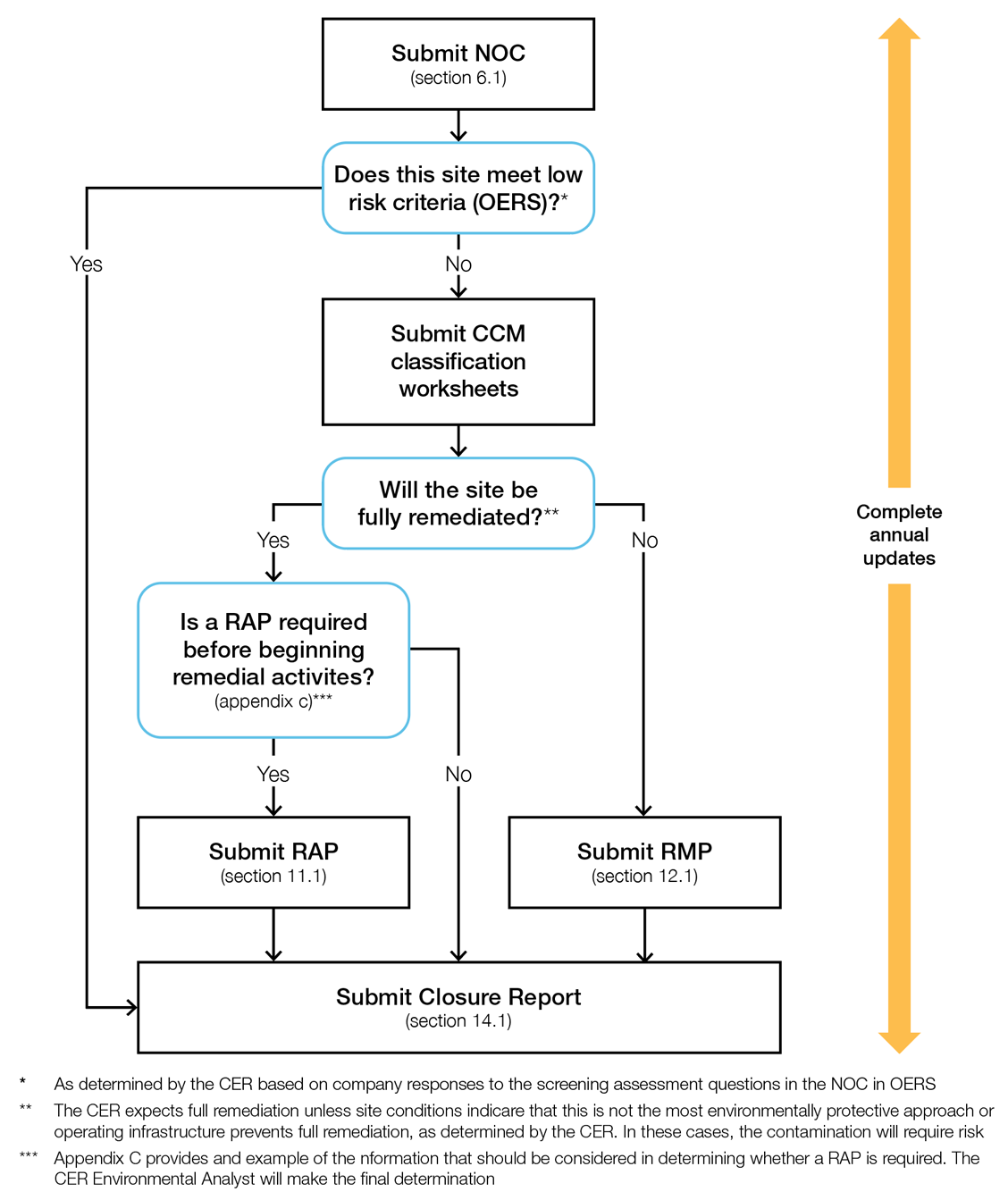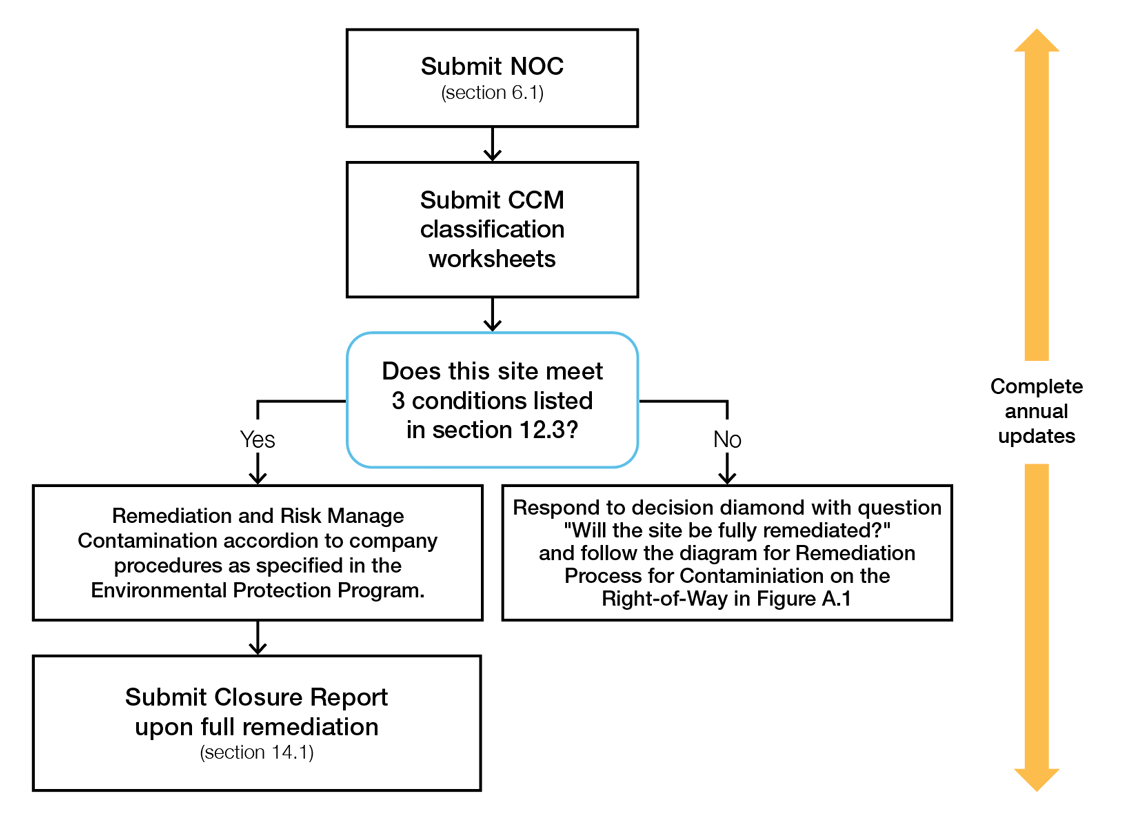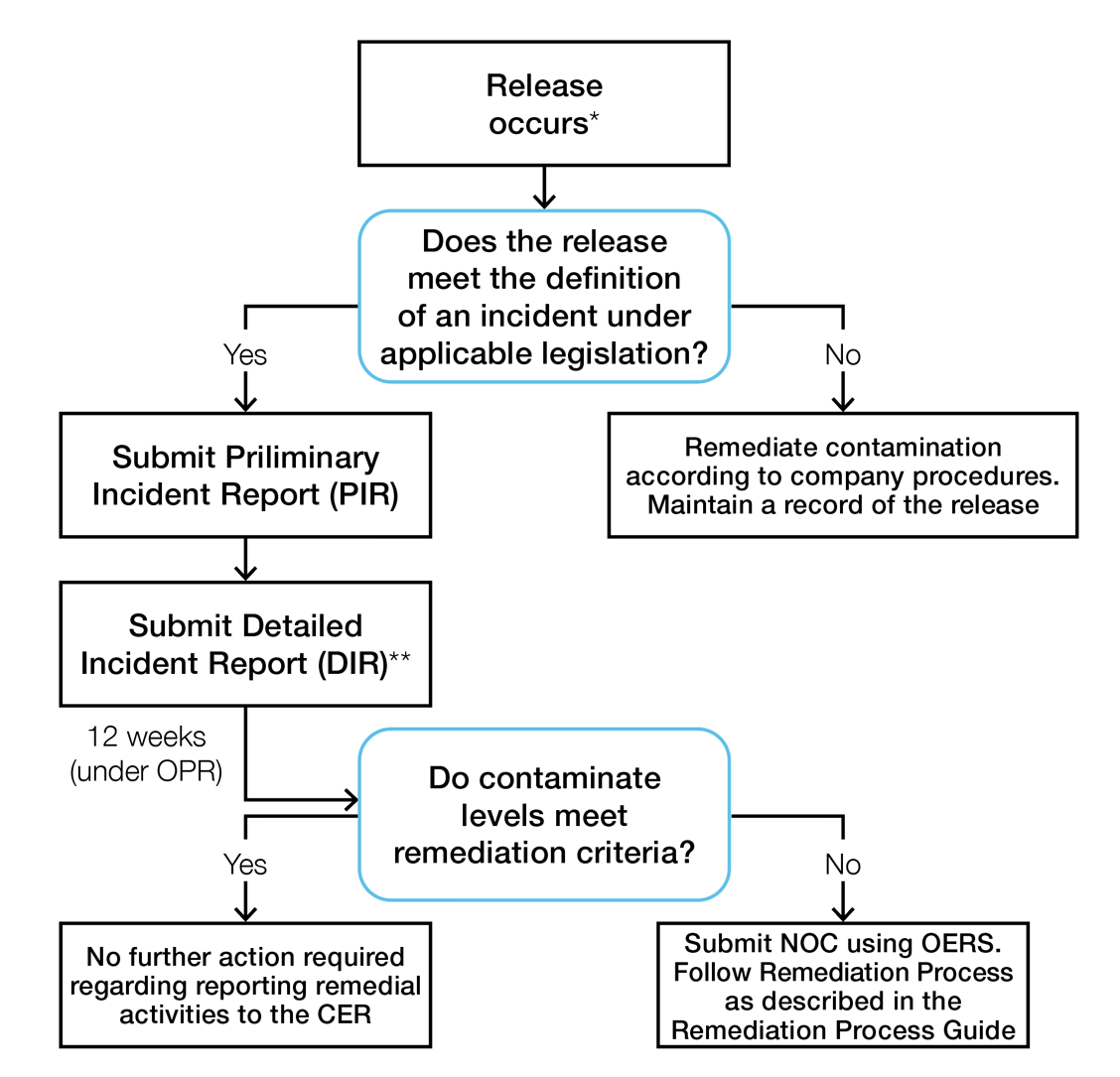16. Contact Information
To provide feedback or ask a question regarding the Guide, email remediation@cer-rec.gc.ca.
Direct other inquiries to:
Canada Energy Regulator
210-517 10 Ave SW
Calgary AB T2R 0A8

17. References
Canadian Energy Regulator Act (S.C. 2019, c. 28, s. 10).
Canadian Energy Regulator Onshore Pipeline Regulations (SOR/99-294).
Canadian Energy Regulator Processing Plant Regulations (SOR/2003-39).
Canada Oil and Gas Operations Act (R.S.C., 1985, c. O-7).
Canada Oil and Gas Drilling and Production Regulations (SOR/2009-315).
CCME. 2020. Ecological Risk Assessment Guidance Document. PN 1585.
CCME. 2016. Guidance Manual for Environmental Site Characterization in Support of Environmental and Human Health Risk Assessment (volumes 1 through 4). Canadian Council of the Ministers of the Environment, Winnipeg. PN 1551, 1553, 1555 and 1557.
CCME. 2008. National Classification System for Contaminated Sites: Guidance Document. Canadian Council of Ministers of the Environment, Winnipeg. PN 1403.
CSA (R2016) Phase I Environmental Site Assessment (Z768-01). Toronto. Canada: Canadian Standards Association.
CSA (2013) Phase II Environmental Site Assessment (Z769-00). Toronto. Canada: Canadian Standards Association.
CSA Z662:19 (2019). Oil and Gas Pipeline Systems. Toronto. Canada: Canadian Standards Association.
DFO (Fisheries and Oceans). 2011 Framework for Addressing and Managing the Aquatic Contaminated Sites under the Federal Contaminated Sites Action Plan (FCSAP).
Environmental Management Act, SBC 2003, c. 53, retrieved on 20 April 2020.
Health Canada (2010) Federal Contaminated Site Risk Assessment in Canada, Part I –IV. (https://www.canada.ca/en/health-canada/services/environmental-workplace-health/contaminated-sites/guidance-documents.html). Retrieved 6 August 2020.
Oil and Gas Operations Act (S.N.W.T. 2014, c. 14).
Oil and Gas Drilling and Production Regulations (R-027-2014).
18. Appendices
Appendix A Remediation Process for Contamination
Figure A.1: Remediation Process flowchart for Contamination identified on the right-of-way

Figure A.2: Remediation Process flowchart for Contamination identified on Company Owned or Leased Lands

Notes for Figure A.1 and Figure A.2:
- At any time throughout this process, the CER Environmental Analyst may issue an information request (IR) or recommend to the CER compliance program manager that a compliance verification activity be carried out. A compliance verification activity could include a field inspection or compliance meeting and lead to enforcement actions, when required.
- As described in sections 11.3 and 12.2, the RAP and/or RMP will be reviewed and upon a satisfactory assessment, accepted by the CER Environmental Analyst. The CER Environmental Analyst may require further information, plan revisions or require certain conditions be met prior to RAP or RMP acceptance.
- As described in section 14.3, the Closure Report will be reviewed by the CER Environmental Analyst. Upon a determination that the Closure Report is satisfactory to the CER Environmental Analyst, a recommendation will be made to the CER Director of Environmental Protection to issue a Remediation Closure Letter for the site. The CER Director of Environmental Protection will make the final decision to issue the Remediation Closure Letter.
Figure A.3: A summary of the steps involved in transitioning a Release that is reported as an Incident to Remediation of a site with Contamination under the CER Remediation Process

Appendix B Concordance Tables
Concordance tables will be required for Appendix F, Appendix G and Appendix H.
Table 18.1: Remediation Criteria and Result Template
Contaminant of Concern |
Land Use |
Applicable Federal guideline (mg/kg) |
Applicable Provincial Guideline 3 (mg/kg) |
Soil Remediation Criteria Selected (mg/kg) |
|---|---|---|---|---|
Benzene |
Agricultural, as described in sections XX of the submitted report |
0.0068Table Note a |
0.046Table Note b |
0.0068 |
Fraction 2 |
Agricultural, as described in sections XX of the submitted report |
150Table Note c |
150 |
150 |
References for Guidelines Considered |
||||
Table 18.1 provides an example of the information for companies to include in the Concordance Table. The Concordance Table should include only a high level description with references to the location in the reports that provide details. This example includes only Remediation Criteria for soil; the Concordance Table should include tables with Remediation Criteria for Contaminants of Concern in all relevant media (e.g., groundwater, sediment). The Concordance Table in the RAP should be updated as required for inclusion in the Closure Report. An example of content to include in the Closure Report is below:
Supporting Information for Remedial Endpoint Selection
Soil Texture: FINE, as demonstrated with textural analysis in section XX of the report, and borehole logs in Appendix X of the submitted report.
Table 18.2: Company Commitments Related To Site Remediation
Issue |
Objective |
Results |
Notes |
|---|---|---|---|
Creek restoration including installation of erosion matting |
Creek restored to condition equivalent to condition prior to remedial activities. Landowner is satisfied with restoration activities. |
Creek restored and landowner satisfied with condition of restored creek. |
|
Table 18.2 provides a summary of commitments related to Remediation of the site with Contamination, if relevant.
Appendix C Assessment Guide for RAP Requirement
After companies submit a NOC in OERS, and CCME classification worksheets for Contamination encountered on the RoW, the next step required most often is the development and submission of a RAP. Companies are expected to develop and implement a RAP. Read more about the requirements for the Next Steps after Reporting Contamination in section 6.2.
A RAP may not be required if justification is provided indicating that Contamination can be remediated to generic criteria, and Contamination presents little Risk to Receptors. In this case, after submitting the NOC, CCME site classification worksheets, and subsequent completion of Remediation, the next step is submitting a Closure Report to the CER. Justification for not completing a RAP should be included in the annual update. If a RAP is not developed and submitted to the CER for acceptance, we do not provide any assurance that the remedial activities or selected Remediation Criteria described in the Closure Report will be accepted.
The questions in Table 18.3 provide examples of the type of information the Environmental Analyst considers in determining whether a RAP is required, or whether it is appropriate to proceed directly to Remediation, followed by submitting a Closure Report. Table 18.3 also provides examples of the type of information that should be included in the justification for why a RAP may not be required. The Environmental Analyst will exercise professional judgement in deciding whether a RAP is required, based upon information submitted in the NOC, CCME worksheets, annual updates and any additional relevant information requested by the CER. Responding in the affirmative to the questions in the table below indicates a RAP may be required.
Read more about RAP Requirements in section 11.1.
Table 18.3: Worksheet That Indicates a RAP May be Required
Appendix C Assessment Guide for RAP Requirement [PDF 87 KB]
Appendix D Risk Assessment
Assessment of hazards and Risks are part of the Remedial Action Plan, Risk Management Plan, and Closure Report development process. A human health and/or ecological Risk Assessment may also be carried out at certain sites. Table 18.4 provides a brief summary of the information that should be included in an ecological and human health Risk assessment. Many items in the Problem Formulation portion of the table are key elements of a well-developed conceptual site model, which is necessary in developing a RAP or RMP, or in demonstrating that Remediation is complete in a Closure Report.
CCME and Health Canada approaches to risk assessment are recommended; however, provincial approaches may be acceptable.
Read more about Risk Management in section 12.
Read about the Limited Exception to Application of Generic Remediation Criteria in section 11.5.
Table 18.4: Summary of Risk Assessment Worksheet
Appendix D Risk Assessment [PDF 78 KB]
Appendix E Contamination Scenarios and Required Actions
The table below provides examples of Contamination scenarios that companies may encounter, along with the required actions. Refer to the Guide and all applicable laws for complete details and requirements on the required actions.
If there are questions or concerns on any steps within the Remediation Process, contact remediation@CER-one.gc.ca for assistance with scenarios specific to the contaminated site.
Read about Reporting Contamination to the CER in section 6.
Table 18.5: Contamination on the RoW
| CER-Regulated Energy Infrastructure Contamination Scenarios and Expected Actions | |
|---|---|
New Releases, Non-Reportable Incidents |
|
Scenario |
Required Actions |
Scenario 1 A contaminant Release occurs (liquid or solid) that meets all of the following criteria:
|
Scenario 1
Note: If a Release occurs that is not reportable as an Incident, but either of the two conditions below apply, a NOC must be submitted to the CER and the Remediation Process followed (as for Scenario 4):
|
Scenario 2 A contaminant Release occurs (liquid or solid) that meets all of the following criteria:
|
Scenario 2
|
Scenario 3 A Contaminant Release occurs (liquid or solid) that meets all of the following criteria:
|
Scenario 3
|
On-site Contamination Identified or Encountered (not a recent Release) |
|
Scenario 4 Contamination is identified or encountered that is not the result of a recent, known, Release. |
Scenario 4
|
Table 18.6: Contamination on Company-Owned or Leased Lands
Potential scenarios and required actions for Contamination on company-owned or leased lands |
|
|---|---|
| New Releases, Non-Reportable Incidents | |
Scenario |
Required Actions |
Scenario 5 A contaminant Release occurs (liquid or solid) that meets all the following criteria:
|
Scenario 5
Note: If a Release occurs that is not reportable as an Incident, but either of the two conditions below apply, a NOC must be submitted to the CER and the Remediation Process followed.
|
New Releases, Reportable Incidents |
|
Scenario 6 A contaminant Release occurs (liquid or solid) that meets all of the following criteria:
|
Scenario 6
|
Scenario 7 A contaminant Release occurs (liquid or solid) that:
|
Scenario 7
|
Scenario 8 Contamination is identified or encountered at a location that meets the following criteria:
|
Scenario 8
|
Table 18.7: Third Party Contamination
| Potential scenarios and required actions for Contamination on All Lands |
|
|---|---|
| Third Party Contamination | |
Scenario |
Required Actions |
Scenario 9 Contamination is discovered on All Lands and investigation confirms that the Contamination is not attributable to the company’s Facilities |
Scenario 9
|
Notes
1. Incidents reportable to the CER under applicable laws, and additional associated guidance, are summarized in the CER Event Reporting Guidelines.
2. Should off-site migration of Contamination occur within any of these situations, notify the CER and other government authorities as required by law (section 6.3).
3. In all scenarios, contaminated soils and/or liquids must be transported off-site and disposed of pursuant to applicable laws.
4. Although engagement steps are not included in the scenarios for Company-Owned or Leased lands, we expect engagement to be considered for all sites with Contamination (section 7).
Appendix F Remedial Action Plan (RAP) Worksheet
Appendix F Remedial Action Plan (RAP) Worksheet [PDF 91 KB]
Read more about the requirements for the Remedial Action Plan in section 11.2.
Table 18.8: RAP Contents
Appendix G Risk Management Plan (RMP) Worksheet
Read more about Risk Management Plan (RMP) Contents in section 12.1.
Table 18.9: Risk Management Plan Contents
Appendix G Risk Management Plan (RMP) Worksheet [PDF 72 KB]
Appendix H Closure Report Worksheet
Read more about Site Closure in section 14.
Table 18.10 Closure Report
Appendix H Closure Report Worksheet Version 2.0 (June 2023) replaces Appendix H Closure Report Worksheet.
Appendix I Declaration Letter
Appendix I Declaration Letter [PDF 58 KB]
This Declaration Letter must be signed by:
- An accountable officer, if the facility owner is required to appoint such an accountable officer pursuant to section 6.2 of the Canadian Energy Regulator Onshore Pipeline Regulations (OPR); OR
- Where there is no accountable officer required pursuant to the OPR, an officer or director of the company which owns the facility to which the closure letter relates
and must be submitted to the Canada Energy Regulator (CER) with the Closure Report.
I, name, the accountable officer of company name, declair:
This application for a Closure Letter for remediation event was prepared and completed under my direction. Based on my inquiries of the person or persons who managed the application components required to complete this application the information is, and the complete application is, to the best of my knowledge and belief, true, accurate and complete:
- All remedial activities were conducted in accordance with the Remedial Action Plan and/or Risk Management Plan, if applicable, and the Closure Report. If Work was not conducted in accordance with these documents, detailed reasons for deviation were included in the Closure Report.
- The contaminants specified in the Closure Report were remediated to the more stringent of federal
or provincial generic Remediation Criteria for the appropriate land use or the established Site Specific Remediation Objectives as stated in the Remedial Action Plan and/or Risk Management Plan, if applicable, and the Closure Report. - Any commitment made by the company to the CER and to potentially affected persons regarding Remediation of Contamination, and additional mitigation, has been met. In the event the commitment was not met, a detailed statement was included in the Closure Report as to why this commitment could not be or was not met.
- All potentially affected persons were notified of the Contamination and remedial activities and engaged on the plans for remediation and site closure in compliance with section 7 of the 2020 CER Remediation Process Guide. In the event this requirement was not met, a detailed statement was included in the Closure Report as to why this requirement could not be or was not met.
- Any outstanding concerns identified by potentially affected persons or other regulators, and actions
to address these concerns, or an explanation as to why no further action is required to address these concerns or comments, have been described in the Closure Report.
Name: |
Position: |
Signature : ________________________________________ |
Date : |
- Date modified:
